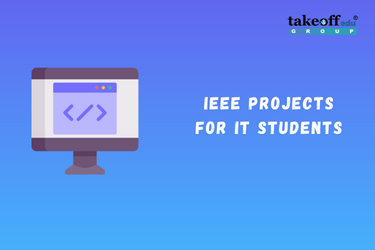Students are encouraged to put their theoretical knowledge to practice in their final year projects as part of the course programme. Students can obtain the skills and knowledge necessary to tackle technical and commercial challenges in the real world by working on final year projects.
In order to gain comprehensive knowledge and develop abilities in a particular topic, students can pick their capstone projects depending on their interests and areas of concentration.
One of the most important years of your education for the advancement of your professional career is the last year of an engineering programme, whether it be a BE/BTech or MTech programme. Final-year projects in CSE (Computer Science and Engineering) or IT (Information Technology) provide students with a fantastic opportunity to get practical experience that is essential to their careers.
This blog will give you some tips about what major project and IEEE project is, why to do IEEE projects, Top IEEE projects for IT final year students done by Takeoff Projects along with the top major projects for IT final year. First let us look at the basic information about major project.
What is Major Project?
Students get the opportunity to put their conceptual, practical, and academic abilities they have learned during their bachelor's degree to use in their final year project. A written project and an oral presentation make up its two distinct formats. Depending on the programme, each component of the project has a separate set of guidelines that the student must adhere to. For this reason, I advise all students to thoroughly study the syllabus before beginning the project.
Significance of Doing Major Projects
Regardless of the project type you decide on, make sure to give it adequate thought. Final-year projects are crucial for a number of reasons:
The major project is the most significant piece of work we will do during our UG/PG course.
This gives us the opportunity to focus on a subject we are passionate about.
It also enables us to demonstrate a wide range of the skills and information we have learnt during the course.
From the employee's perspective, it is possible that they may inquire about the project during the interview.
What are IEEE Projects?
IEEE stands for (Institute of Electrical and Electronics Engineers). IEEE is an organisation made up of engineers, scientists, and students. It is widely known for developing standards for the computer and electronics sectors. IEEE Projects are the bulk of projects developed with IEEE standards. Students are currently encouraged to finish IEEE projects. On IEEE standards, PhD researchers frequently base their research.
Why to do IEEE Projects?
IEEE is a very professional standard, aside from other publications. Many people from many industries are members of IEEE. A community is motivated by books, gatherings, conventions, norms, and technology. A technology is advanced by each article that appears in an IEEE publication. Many publications outlining fresh innovation tactics are published each year.
You should have a solid technical background and be knowledgeable about the many career routes that are open to you if you want to pursue a career in engineering. A strong senior project can help you do this. The IEEE Projects for IT Final Year Students are covered in this blog.
Top IEEE Projects for IT Final Year Students
This section gives the Major Projects for IT Students based on the brief descriptions and explanations about some of top IEEE Projects for IT Final Year Students done by the Takeoff Projects.
Blockchain for Secure EHR's Sharing of Mobile Cloud Based E-Health Systems
The decentralised interplanetary file system (IPFS) and blockchain were used on a mobile cloud platform to create a revolutionary EHRs sharing architecture in this article. To ensure safe EHR exchange between various patients and medical professionals, a reliable access control system was specifically created utilising smart contracts. Following that, a working prototype implementation using the Ethereum blockchain in a real-world data exchange scenario on a mobile app powered by Amazon cloud computing was shown.
Click here for the detailed information of the project.
A Model-Driven Deep Dehazing Approach by Learning Deep Priors
Photos taken in hazy weather are usually covered with white masks and lose important details. Haze removal is a fundamental task and a prerequisite to many other vision tasks. Single image dehazing is an ill-posed inverse problem that has attracted much attention in recent years. Generally, current single dehazing methods can be categorized into the traditional prior-based methods and the data-driven deep learning methods that respectively investigate haze-related image priors and deep architectures. With the help of computer vision techniques, the hazy part are removed from the images and our method achieves promising performance for single image dehazing.
Click here for the detailed information of the project.
An Enhanced Ensemble Diagnosis of Cervical Cancer A Pursuit of Machine Intelligence Towards Sustainable Health
An appropriate diagnosis addressing the patient's medical issues or symptoms is proposed in this research study using an ensemble classification approach based on majority voting. A wide range of classifiers, including DT (Decision Tree), SVM (Support Vector Machine), RF (Random Forest), KNN (K-Nearest Neighbor), NB (Naive Bayes), MP (Multiple Perceptron), and LR (Logistic Regression) classifiers, were experimented in this work. The study reports an increase in prediction accuracy of 94%, which was much higher than the prediction accuracies of single classification methods evaluated on the same benchmark datasets. In order to identify diseases and treat them quickly, the suggested paradigm provides health professionals access to a second opinion.
Click here for the detailed information of the project.
A Decision Tree Based Recommendation System for Tourists
In this research, a brand-new human centered TRS is proposed that suggests places to travellers in a strange city. It uses a real to consider both technical and pragmatic concerns. The system is created utilising a two-step feature selection approach to cut down on the amount of inputs, and C4.5 decision tree provides suggestions. The findings of the trial demonstrate that the suggested TRS may offer customised recommendations for tourism hotspots that please travellers.
Click here for the detailed information of the project.
Efficient Prediction of Cardiovascular Disease Using Machine Learning Algorithms With Relief and LASSO Feature Selection Techniques
Early detection of cardiovascular illnesses may lead to prevention or mitigation, which may lower death rates. A viable strategy is to find risk variables using machine learning algorithms. To effectively forecast cardiac disease, it would be ideal to suggest a model that includes a variety of techniques. We have successfully created correct data for the training model using effective approaches for Data Collection, Data Pre-processing, and Data Transformation. A UCI Heart Disease dataset was utilised. To enable comparisons, the findings are presented individually. The suggested model provided the maximum accuracy when employing RFBM and Relief feature selection techniques, it can be inferred from the result analysis.
Click here for the detailed information of the project.
Detection and Predicting Air Pollution Level in a Specific City Using Machine Learning Models
One of the most crucial issues for the governments of emerging nations, particularly India, is the management of the fast-rising levels of air pollution. It is crucial that individuals are aware of the extent of the pollution in their immediate environment and take action to reduce it. Air pollution is significantly influenced by weather and traffic variables, the burning of fossil fuels, and industrial factors including power plant emissions. When determining the air quality, particle matter (PM) is one factor. It poses major risks to people's health when its concentration in the air is high. Consequently, it is crucial to manage it by regularly monitoring its level in the air.
Click here for the detailed information of the project.
Data Mining Approach to Find the Interest of People in Purchasing RealEstates
This survey collects different sorts of data in addition to information on people's interest in certain homes. Then, using specific data mining methods, they are transformed into data chains that enable forecasting of the public's interest in the types of properties they are most likely to acquire as well as the locations where they are most likely to do so. To categorise the data in this case based on certain attributes, two data mining techniques—clustering and classification—are applied. These results are then used to generate a number of graphs.
Click here for the detailed information of the project.
Comments on “Provable Multi copy Dynamic Data Possession in Cloud Computing Systems"
Replication is a key strategy utilized in this project for the cloud service provider to ensure data availability. Numerous multi-copy integrity auditing systems were introduced to give consumers persuasive proof that the copies they need are all kept appropriately. However, it was demonstrated that this technique is easily vulnerable to copy-summation attacks and single copy attacks, where a dishonest CSP just has to invest a single copy's worth of storage costs in order to always pass the verifier's challenge. As a result, in this instance, the scheme is no longer secure.
Click here for the detailed information of the project.
Iris Based Human Identity Recognition with Deep Learning Methods
The iris has attracted increased attention recently as a biometric characteristic. This quantifiable feature's high efficiency and accuracy guarantees were to blame for it. In the literature, the effects of this curiosity may be seen. Different writers have recommended various, varied ways. An iris-based human identification recognition algorithm is presented by the authors in this work using their own methodology. The technique utilised artificial neural networks and CNNs for classification. Once the output has been categorised, the segmentation process is carried out on the output, and the iris portion is segmented. The proposed approach can produce results that are adequate, according to tests that have been conducted.
Click here for the detailed information of the project.
Detection Of Plant Disease Using Machine Learning and Deep Learning Algorithms
For the most part, plants like apple, tomato, cherry, and grapes have apparent disease signs on their leaves. It is possible to recognise these obvious characteristics in order to accurately forecast the disease and take proactive measures to prevent it. Deep learning and machine learning methods can be used to get around this. As a result, we are putting forth a technique for identifying a tomato plant's illness from its leaf photos. Here, the procedure is carried out using deep learning algorithms CNN, RNN, and ResNet, one of CNN's transfer learning techniques, along with SVM, RF, and other machine learning algorithms. Following algorithm training on the dataset, the algorithms' accuracy is compared, and the photos are categorised.
Click here for the detailed information of the project.
Top Major Projects for IT Final Year
The top Major Projects for IT Final Year across different domains like Python and Java are provided in this section. Some of the IEEE Projects for IT Final Year Students in these domains are listed below.
Python Major Projects for IT Final Year
Brain Disease Classification Along with Age Estimation from MRI
Sentiment Classification from Text Using Deep Learning Algorithm
Multi class Prediction Model for Student Grade Prediction Using Machine Learning
Detecting the Security Level of Various Cryptosystems Using Machine Learning Models
Covid-19-Preventions-Control-System and Unconstrained Face-Mask And Face-Hand Detection Framework
A Survey on Machine Learning Techniques For the Diagnosis of Liver Disease
A Block Chain Based Covid Vaccine Booking and Vaccine Management System
Click here for more Python Project Ideas.
Java Major Projects for IT Final Year
A Study On ABE Public Key On Cryptographic Technique project
TOWARD EFFICIENT ENCRYPTED IMAGE RETRIEVAL IN CLOUD ENVIRONMENT
Privacy Preserving Multi-keyword Searchable Encryption for Distributed Systems
Authentication and Key Agreement based on Anonymous Identity for Peer-to-Peer Cloud
A Higher-Level Security Scheme for Key Access on Cloud Computing
PDD Predictive Diabetes Diagnosis using Data mining Algorithms
Effect of Data Parameters and Seeding on k-Means and k-Medoids
Research on Tax Collection and Administration on Big Data Analysis
Multi-Source Medical Data Integration and Mining for Healthcare Services
A Parallel and Forward Private Searchable Public-Key Encryption for Cloud-Based Data Sharing
A Secure Data Dynamics and Public Auditing Scheme for Cloud Storage
A Computational and Analytical Approach for Cloud Computing Security with User Data Management
Dual Access control for Cloud Based Data Storage and Sharing
A Verifiable Semantic Searching Scheme by Optimal Matching Over Encrypted Data in Public Cloud
Click here for more Java Projects with Source Code.
Conclusion
This blog article gives you some important tips about the basic concepts of major project and IEEE project. Then the reason behind their significance is also stressed in “Why to do IEEE final year projects”. Then top IEEE projects for IT final year students done by Takeoff Projects along with the top major projects for IT final year are listed.
Why Takeoff Projects? How can it help with the Major Projects for IT Final Year?
Takeoff Projects offers a specialized sector of professionals and instructors that are subject matter experts in many fields. Many students have received help from Takeoff Projects in finishing projects from a range of businesses. We can efficiently complete major projects for IT final year during the allocated time, from the beginning state to the finished state. We also offer suggestions for enhancing the probability of IEEE projects for IT final year students to get approved. You can either choose from your own suggestions or draw ideas from our list of major projects for IT final year.
Also read : ieee projects for electrical engineering
 Paper Publishing
Paper Publishing
 Mini Projects for IT Students
Mini Projects for IT Students  Projects for IT Students
Projects for IT Students 



